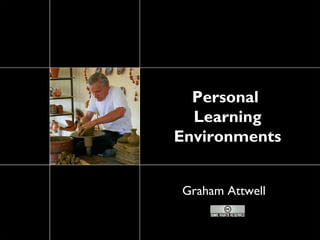
Personal learning enviroments
- 1. Personal Learning Environments Graham Attwell
- 2. Personal Learning Environments - a concept based on Web 2 .0 and social software
- 3. We are at present undergoing a deep and prolonged industrial revolution based on digital technologies
- 4. The reform and reshaping of social systems and institutions has tended to lag behind in periods of rapid technological change
- 5. Profound innovations in technology tend to be reflected in older paradigms
- 6. for example the ‘virtual classroom’ or the ‘Virtual Learning Environment’
- 8. It is not the development of technology per se which poses such a challenge to education systems and educational institutions
- 9. but the changing ways in which people are using technologies to communicate and to learn and the accompanying social effect of such use
- 10. My Space and Bebo
- 11. Web logs
- 13. forming and participating in on-line social networks and communities
- 14. The reaction of education systems and institutions to the rise of social networking has been at best bewilderment, at worst downright hostility
- 15. a refusal to engage in these issues risks school becoming increasingly irrelevant to the everyday lives of many young people
- 16. and particularly irrelevant to the ways in which they communicate and share knowledge
- 17. Web 2.0 allows young people to be active co- creators of knowledge
- 18. We have to review the industrial schooling model including the organisation of institutions and pedagogy and curriculum
- 19. It is not just young people who use social software for learning
- 20. Social software is widely used in the workplace for informal learning
- 21. Most informal learning is learner driven, problem based, or motivated by interest
- 22. Google is the most used e-learning application
- 23. most learning is unaccredited
- 24. people learn through legitimate peripheral participation
- 25. Knowing is .... located in relations among practitioners, their practice, the artefacts of that practice, and the social organization…of communities of practice Lave and Wenger, 1991
- 26. Lurking is a means of becoming integrated in distributed communities of practice
- 27. In such communities of practice formal learning materials are seldom used
- 28. We have ignored the vast potential of freely available ‘objects’ of all kinds for learning purposes .
- 29. changes in the way in which we learn and develop new competences is a challenge to our traditional subject organisation
- 30. And although most countries have adopted a rhetoric of lifelong learning, there is little sign that education systems have sufficiently changed to facilitate such a movement.
- 31. The answers?
- 32. How can we support lifelong competence development?
- 33. Personal Learning Environments have the potential to meet such a challenge
- 34. PLEs are not another substantiation of educational technology but a new approach to learning
- 35. A response to pedagogic approaches which require that learner’s e-learning systems need to be under the control of the learners themselves.
- 36. and recognise the needs of life-long learners for a system that provides a standard interface to different institutions’ e-learning systems, and that allows portfolio information to be maintained across institutions.
- 37. Learning is now seen as multi episodic, with individuals spending occasional periods of formal education and training throughout their working life.
- 38. PLE are based on the idea that learning will take place in different contexts and situations and will not be provided by a single learning provider
- 39. the idea of a Personal Learning Environment recognises that learning is continuing and seeks to provide tools to support that learning
- 40. Using whatever tools and devices which the learners choose
- 41. It also recognises the role of the individual in organising their own learning
- 42. PLEs can help in the recognition of informal learning
- 43. PLEs can develop on the potential of services oriented architectures for dispersed and networked forms of learning and knowledge development.
- 44. “the heart of the concept of the PLE is that it is a tool that allows a learner (or anyone) to engage in a distributed environment consisting of a network of people, services and resources. It is not just Web 2.0, but it is certainly Web 2.0 in the sense that it is (in the broadest sense possible) a read-write application.” Stephen Downes, 2006
- 45. The promise of Personal Learning Environments could be to extend access to educational technology to everyone who wishes to organise their own learning.
- 46. The ‘pedagogy’ behind the PLE – if it could be still called that – is that it offers a portal to the world, through which learners can explore and create, according to their own interests and directions, interacting at all times with their friends and community
- 47. the PLE will challenge the existing education systems and institution
- 48. New forms of learning are based on trying things and action, rather than on more abstract knowledge.
- 49. Policies to support the development and implementation of PLEs
- 50. encouraging and supporting the development of communities of practice and engagement in those communities
- 51. decisions over funding and support need to be taken as close to practice as possible
- 52. a broader understanding of digital literacy and its integration within the curriculum s
- 53. recognise different forms and contexts of learning
- 54. the development and adoption of new pedagogies
- 55. the co-shaping of technologies bringing together techies and teachers, enterprises and institutions
- 56. Thanks for Listening Wales Wide Web -www.knownet.com/writing/weblogs/Graham_Attwell
